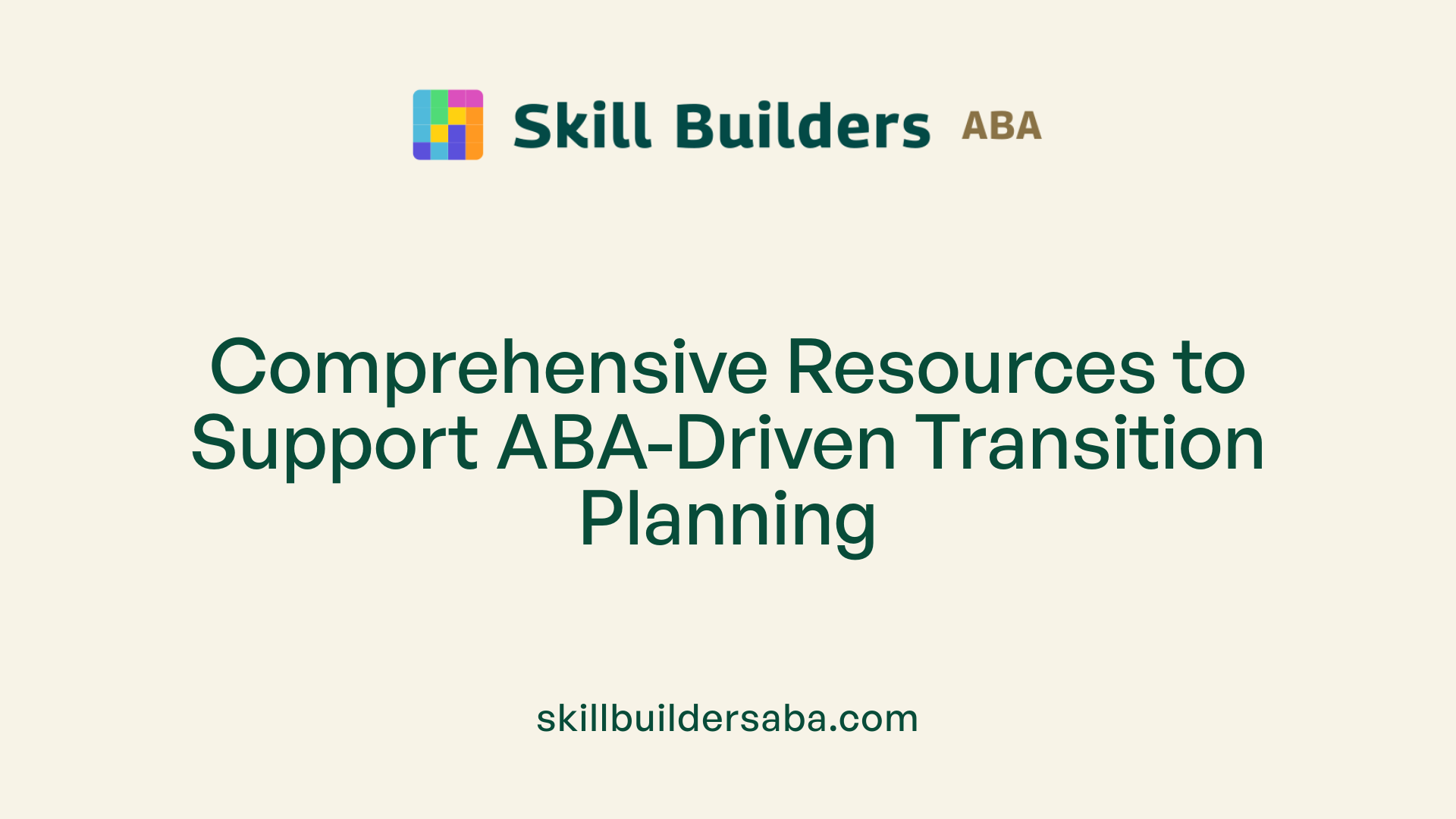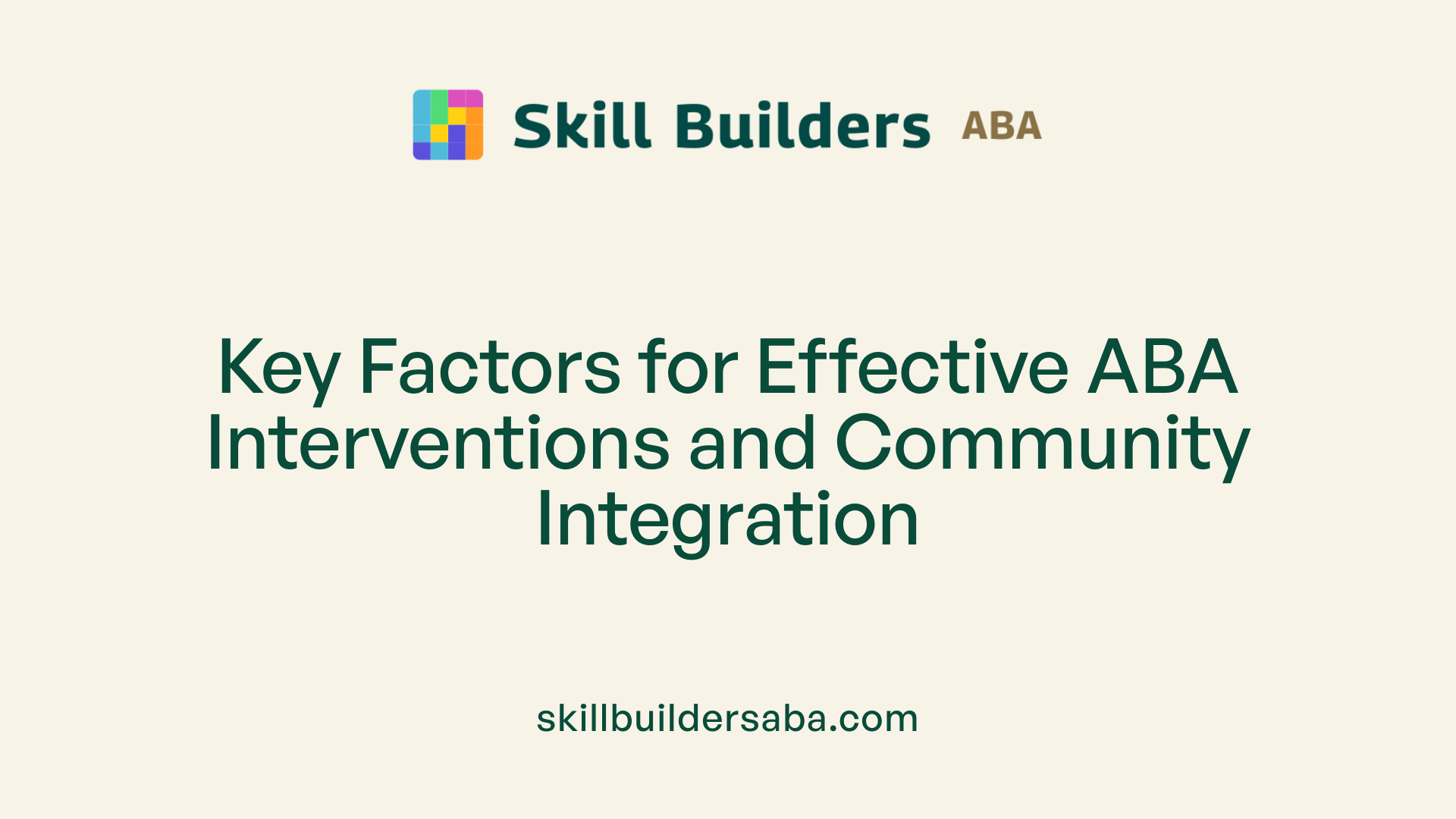
Supporting transitions to adulthood using ABA principles
Empowering Young Adults with Autism Through Evidence-Based Strategies
An Essential Approach to Navigating Life’s Transitions
Transitioning into adulthood poses unique challenges for individuals with autism spectrum disorder (ASD). Applying the principles of Applied Behavior Analysis (ABA) offers a structured, scientifically supported method to facilitate these important life changes. By focusing on skill development, independence, and adaptive behavior, ABA serves as a cornerstone for supporting young adults in achieving their goals and fostering resilience within complex social and community environments.
Frameworks and Resources Supporting ABA in Transition Planning
 Are there resources or frameworks that support the application of ABA principles in transitioning to adulthood?
Are there resources or frameworks that support the application of ABA principles in transitioning to adulthood?
Yes, multiple resources and frameworks are available to assist in applying ABA in the transition to adult life for individuals with autism spectrum disorder (ASD). One prominent example is the legal and educational mandate provided by the Individuals with Disabilities Education Improvement Act (IDEIA). This law emphasizes the importance of individualized transition planning, ensuring that each young person receives tailored services and goals that promote independence and community participation.
Within this context, specialized curricula like TeachTown play a significant role. TeachTown offers programs designed for learners with disabilities, integrating ABA principles to teach social skills, communication, and daily living skills. These curricula are structured to support students from early childhood through transition age, ensuring continuity and consistency in applying behavioral strategies.
Furthermore, evidence-based community programs focus on expanding social skills and employment readiness, which are crucial aspects of adult independence. Supported employment initiatives provide real-world work experiences, guided by ABA strategies to enhance job skills and social interactions.
Combining these elements—legal frameworks, specialized curricula, and practical community interventions—facilitates a comprehensive approach. This approach promotes skill development, self-advocacy, and autonomy, leveraging ABA principles throughout the transition process.
| Resource/Framework | Description | Application in Transition |
|---|---|---|
| IDEA (Individuals with Disabilities Education Improvement Act) | Mandates individualized transition planning from age 16 | Guides development of personalized goals and services |
| TeachTown | ABA-based curriculum for students with disabilities | Prepares skills applicable to adulthood |
| Supported Employment Programs | Provide job training and placement | Apply ABA strategies to foster independence |
| Social Skills and Life Skills Programs | Community programs focused on social integration and daily living | Use structured ABA techniques to improve skills |
Overall, these tools and policies, grounded in ABA science, are crucial in supporting successful transitions to adult independence for individuals with ASD.
Behavioral Supports for Transition: Visual Cues and Time Management
 Transitioning from one activity or environment to another can be challenging for individuals with autism, especially when they experience difficulty with flexibility or predictability. To facilitate smoother transitions, behavioral supports such as visual cues and effective time management tools are essential.
Transitioning from one activity or environment to another can be challenging for individuals with autism, especially when they experience difficulty with flexibility or predictability. To facilitate smoother transitions, behavioral supports such as visual cues and effective time management tools are essential.
Visual supports include a variety of tools that provide clear, visual information about upcoming changes. Visual schedules display routines and steps with images, photographs, or icons, helping individuals anticipate what will happen next. This reduces anxiety and increases independence as they learn to follow daily routines.
Timers and countdown systems are also valuable, offering a tangible sense of how much time remains before a transition occurs. These cues help individuals prepare mentally for the change and manage their expectations. Transition cards or 'First/Then' boards visually indicate the sequence of activities, clarifying what comes first and what follows.
Environmental cues like objects, photos, or words further signal upcoming transitions, strengthening understanding and reducing confusion. Consistent warnings and clear expectations before transitions, such as saying "In five minutes, we will go outside," prepare the individual, lowering the likelihood of challenging behaviors.
Practicing transitions through social stories and rehearsals allows individuals to become familiar with the process in a low-stress setting. Reinforcing positive behaviors during transitions with praise or preferred items encourages continued cooperation.
Overall, integrating visual supports and time management strategies into daily routines helps individuals with autism experience less stress, develop self-control, and gain greater independence during transitions.
Evidence-Based Strategies for Facilitating Smooth Transitions
What are evidence-based behavioral strategies for facilitating smooth transitions between activities and life stages?
Successfully navigating transitions—such as moving from one activity to another or shifting into new life stages—can be challenging, particularly for individuals with autism spectrum disorder (ASD). Research supports several practical, evidence-based methods to make these moments more manageable and less stressful.
One of the most effective techniques is the use of visual supports. These include visual schedules that break down routines into photographs or icons, timers and countdowns that provide a clear sense of time remaining, and transition objects or cues that signal an upcoming change. These tools help increase predictability, which is vital for reducing anxiety and promoting cooperation.
Priming—giving advance warnings about upcoming changes—can take several forms. Visual cues, such as a picture of the next activity, verbal prompts, or activity notifications, prepare individuals mentally, decreasing surprises and resistance. For example, showing a visual timer or calendar can signal that a transition is approaching, helping individuals adjust their expectations.
In addition, incorporating first-then statements, like “After we finish this game, we will go outside,” explicitly link activities and help establish a structured routine. Offering choices within transitions empowers individuals by giving them some control, which can increase motivation and cooperation.
Tasks can be modified to better suit individual preferences and needs, encouraging engagement and easing the adjustment process. Reinforcement strategies, tailored based on functional assessments, reinforce positive responses and help build tolerance for change.
These strategies are most effective when consistently applied and customized to each person's unique strengths and challenges. When implemented thoughtfully, they significantly enhance transition success and foster independence, making daily routines and life changes less stressful.
According to research, systematically combining visual supports, priming, choice offerings, and personalized task modifications leads to smoother transitions and improved overall behavior in individuals with ASD. These approaches are supported by numerous behavioral studies and are recommended as best practices in behavioral intervention.
Effectiveness of ABA in Promoting Development in Young Adults

How effective is ABA therapy in promoting independence and developmental progress in young adults with autism?
Research shows that ABA (Applied Behavior Analysis) is highly effective in helping young adults with autism improve their independence and various skills crucial for daily life. When programs are tailored to the individual's needs and consistently implemented, ABA can foster growth in areas such as social skills, communication, daily routines, and vocational abilities.
Data from multiple studies highlights that even with less than a full dose of treatment, meaningful progress is often observed. This is especially true for individuals who start with lower levels of functioning. ABA's adaptable strategies allow practitioners to focus on specific goals like job skills or community participation, supporting smoother transitions into independence.
Moreover, ABA emphasizes continuous assessment and program modification, making it possible to meet each young adult’s evolving needs. This flexibility helps in building confidence, reducing dependence, and improving overall quality of life.
In summary, ABA provides scientifically backed, versatile interventions that can lead to significant developmental gains, enabling young adults with autism to become more self-reliant and engaged in their communities.
Additional Insights
| Skill Area | Impact of ABA | Methods Used | Example Application |
|---|---|---|---|
| Social Skills | Improved social interactions and teamwork | Social skills training, role-playing | Engaging in group activities with peer support |
| Communication | Enhanced expressive and receptive language | Picture Exchange Communication System (PECS), FCT | Using communication devices or gestures |
| Daily Living | Increased independence in routine tasks | Reinforcement, task analysis | Cooking, personal care, managing money |
| Vocational Skills | Better job readiness and workplace behavior | Task analysis, role modeling | Preparing for job interviews, task completion |
Search Term for Further Information
For additional insights on how ABA supports adult autonomy, search for "ABA effectiveness in adult autism transition." This can provide more research and case studies illustrating the positive outcomes of ABA interventions for young adults.
Overall, ABA remains a well-supported approach with a proven track record of facilitating meaningful improvements and promoting independence among young adults with autism.
Supporting Transition to Adulthood with ABA

How can ABA principles support the transition to adulthood for individuals with autism and neurodevelopmental disorders?
Applied Behavior Analysis (ABA) offers a structured and evidence-based framework to assist individuals with autism and other neurodevelopmental disorders as they transition into adulthood. By focusing on developing essential functional skills, social competence, and independence, ABA helps prepare individuals for real-world responsibilities.
ABA interventions are tailored to each person’s unique needs, employing techniques like positive reinforcement, modeling, and functional communication training. These strategies encourage desirable behaviors such as effective communication, self-care routines, and social interaction. For instance, using visual schedules and role-playing can teach adults how to navigate community settings or manage daily tasks.
Data collection is a core part of ABA, allowing clinicians and caregivers to monitor progress, identify skill gaps, and modify interventions for better outcomes. This ongoing assessment ensures that skills learned are applicable across various environments, fostering greater independence.
Developing skills such as job responsibilities, community participation, and self-management supports individuals in facing adult life confidently. Additionally, ABA can help reduce maladaptive behaviors that may impede independence.
Despite these benefits, continued research is necessary to evaluate the long-term effects of ABA on employment, social relationships, and overall quality of life for adults. Nonetheless, ABA’s focus on personalized, goal-oriented intervention makes it a valuable tool in supporting meaningful adult transitions.
Criteria for Selecting and Implementing ABA Programs

What factors should be considered when choosing and implementing ABA programs to support successful transition to adulthood?
Selecting the right ABA program for adults preparing to transition into independence requires a careful and comprehensive approach. Primarily, the individual’s unique strengths, preferences, and long-term goals should guide program development. Customized programs that focus on meaningful, socially significant skills increase motivation and ensure relevance.
Evidence-based practices are the foundation of effective ABA interventions. These should include functional assessments and community-based strategies that promote skills in real-world settings such as employment, community participation, and daily routines. Prioritizing independence in areas like personal care, financial management, and social interactions fosters greater autonomy.
Practitioners must adhere to ethical standards, emphasizing safety and respect for the individual’s rights. Having trained professionals with experience in adult populations ensures that complex behaviors are managed appropriately, and progress is reliably measured through systematic data collection.
Systemic factors also influence successful transition outcomes. Family involvement can enhance consistency and support, while collaboration with community organizations and service providers helps access resources like housing, healthcare, and employment opportunities. Advocating for policy support ensures that necessary services are covered and accessible.
Ultimately, a holistic perspective that considers the individual’s desires and community integration is vital. Customizing ABA programs to fit personal goals and social contexts helps foster self-determination and ensures that skills learned are maintained and generalized across various environments. This tailored, community-focused approach contributes significantly to positive adult life experiences.
Ensuring a Pathway to Independence and Fulfillment
Applying ABA principles in transition planning offers a scientifically grounded, flexible, and effective approach to support young adults with autism. By integrating evidence-based techniques such as visual supports, behavioral momentum, and individualized skill development, practitioners and families can facilitate smoother transitions across all life domains. Emphasizing independence, social competence, and community participation, ABA fosters an environment where young adults are empowered to lead fulfilling, autonomous lives. As research advances and resources expand, ongoing collaboration among educators, clinicians, families, and community providers will continue to enhance outcomes, ensuring each individual’s transition into adulthood is both successful and enriching.
References
- What can ABA offer young adults with autism?
- Applied Behavioral Analysis - May Institute
- Applied Behavior Analysis (ABA) | Autism Speaks
- A Review of Behavioral Strategies and Support Considerations for ...
- The Power of Progress: Applied Behavior Analysis (ABA) Therapy ...
- [PDF] Transitioning from Adolescence to Adulthood with Autism Spectrum ...
- [PDF] Transitions ABA in the Classroom - SharpSchool
- ABA Therapy for Adults: Benefits and What to Expect
- Using ABA Strategies to Support Your Child During Transitions
Reach Out Today
Learn more about how we can support your child’s growth and development. Contact us to discuss our services and availability in your area.
.svg)